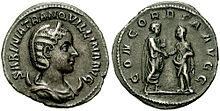
Back الوجه والعكس Arabic Avers a revers Czech Εμπροσθότυπος και οπισθότυπος (Νομισματολογία) Greek Avers i revers Croatian Kepala dan ekor ID Kepala dan ekor Malay Kruis en munt Dutch Awers i rewers Polish Anverso e reverso Portuguese
This article needs additional citations for verification. (January 2013) |


The obverse and reverse are the two flat faces of coins and some other two-sided objects, including paper money, flags, seals, medals, drawings, old master prints and other works of art, and printed fabrics. In this usage, obverse means the front face of the object and reverse means the back face. The obverse of a coin is commonly called heads, because it often depicts the head of a prominent person, and the reverse tails.
In numismatics, the abbreviation obv. is used for obverse,[1] while ℞,[1] )([2] and rev.[3] are used for reverse.
In fields of scholarship outside numismatics, the term front is more commonly used than obverse, while usage of reverse is widespread.[citation needed]
The equivalent terms used in codicology, manuscript studies, print studies and publishing are "recto" and "verso".[citation needed]
- ^ a b David Sear. Greek Imperial Coins and Their Values. Spink Books, 1982. ISBN 9781912667352 p. xxxv.
- ^ Jonathan Edwards. Catalogue of the Greek and Roman Coins in the Numismatic Collection of Yale College, Volume 2. Tuttle, Morehouse & Taylor, 1880. p. 228.
- ^ Allen G. Berman. Warman's Coins And Paper Money: Identification and Price Guide. Penguin, 2008. ISBN 9781440219153